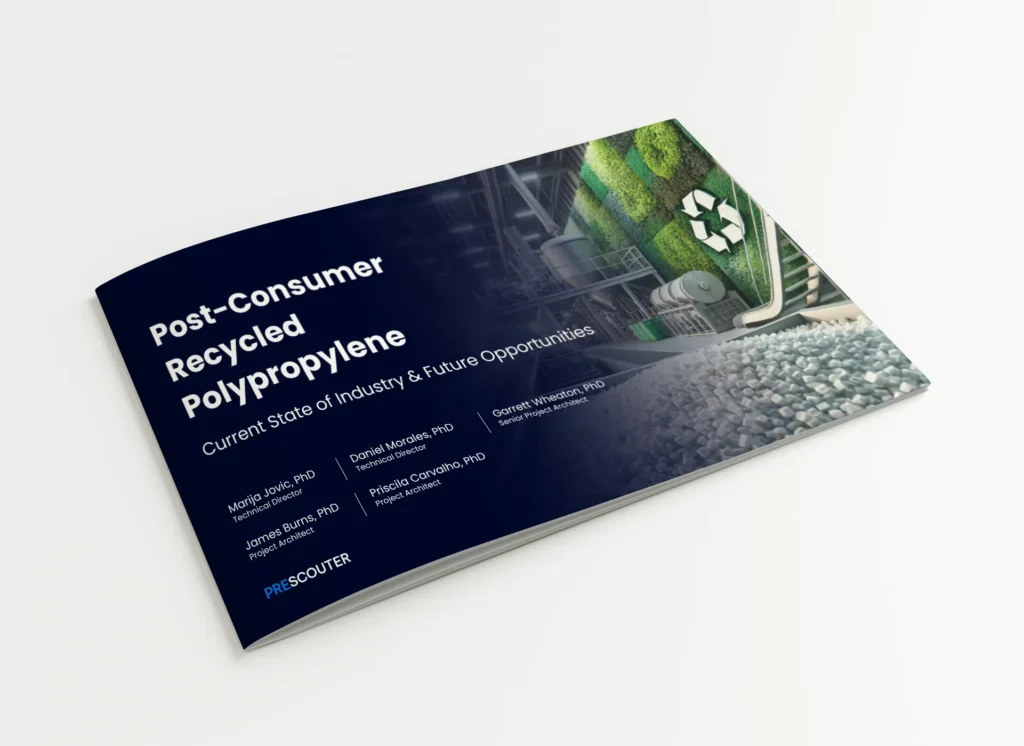Polypropylene (PP) is among the most commonly used plastics worldwide, yet its recycling rates remain exceptionally low than other plastics. Brands have predominantly prioritized recycled polyethylene terephthalate (rPET) to meet their sustainability goals, often neglecting recycled polypropylene (rPP) due to its recycling challenges.
However, post-consumer recycled (PCR) PP holds significant potential for recycling through adopting advanced technologies, strategic partnerships, and engaging brands to increase consumer awareness.
What is polypropylene?
Polypropylene is a lightweight thermoplastic polymer created from propylene monomers through polymerization. Renowned for its stiffness and chemical resistance, PP serves various industries, including packaging, automotive, and healthcare. Its moisture resistance and dimensional stability make it an ideal material for diverse functional applications.
Is polypropylene recyclable?
Yes, polypropylene is recyclable. The polypropylene plastic that is recycled and reprocessed after consumer use is called PCR polypropylene.
The recycling process of this plastic begins with collecting and cleaning used items, such as containers and packaging materials. These materials are then transformed into resin pellets for manufacturing new products, reducing reliance on virgin plastics.
Examining the current market landscape:
Despite making up 16% of U.S. thermoplastic production, polypropylene recycling lags significantly behind other plastics like PET. For instance, polyethylene terephthalate (PET) bottles have a 28% recycling rate, significantly higher than polypropylene (PP) containers at just 8%.
Material Recycling Rate
No Data Found
Source: The Recycling Partnership
In the realm of food-grade resins, the ICIS Mechanical Recycling Supply Tracker reports that recycled resins contribute only 10% to global production. Of this total, recycled PET accounts for 20%, while polyolefins (PP and polyethylene) represent just 3%.
Demand for food-grade recycled polypropylene is outpacing supply, as only 5 companies have FDA approval. To meet the U.S. Plastic Pact’s target of 30% recycled content, a significant increase in production is essential. The current production lags behind demand, creating opportunities for brands to support capital investments in recycling facilities.
Major benefits of PCR polypropylene:
Integrating PCR plastics such as recycled polypropylene into production processes can yield significant environmental and operational advantages. Here are some of the key benefits:
- Promotes sustainability: PCR polypropylene reduces dependence on virgin plastics, conserving natural resources and lowering production costs. It supports a circular economy model by reintroducing waste materials into the supply chain. This minimizes landfill waste and promotes sustainable manufacturing practices.
- Alignment with ESG Goals: Using PCR polypropylene enables brands to meet environmental, social, and governance (ESG) targets set by global regulations. It addresses consumer demand for sustainability while reducing environmental impact. Key industries like packaging, automotive, and consumer goods benefit significantly.
- Support for food-grade applications: Advanced decontamination processes ensure PCR polypropylene meets safety standards for food contact materials. This expands its utility in sensitive industries such as food packaging and healthcare.
- Reduction in carbon footprint: Producing PCR polypropylene requires less energy than virgin plastic production. This leads to lower greenhouse gas emissions, aligning with global carbon reduction initiatives.
- Economic opportunities: Expanding the market for PCR polypropylene creates jobs and drives innovation within the recycling sector. Partnerships between brands and recyclers promote investment in infrastructure and new technologies.
- Multiple applications: PCR polypropylene is versatile and has supporting uses in automotive parts, packaging, and consumer goods. Its availability in multiple grades ensures compatibility with diverse manufacturing needs.
Key challenges in the PCR polypropylene supply chain:
Low consumer participation and inadequate infrastructure are notable barriers to recycling polypropylene. Many recycling facilities face challenges in securing enough post-consumer material for effective processing. Improved collection systems and public awareness campaigns are essential to meet increasing demands for recycled polypropylene.
Contamination
Ensuring high-quality food-grade recycled polypropylene remains a complex task due to contamination issues. Current technologies struggle to remove impurities, limiting the usability of recycled materials. Innovations in purification methods are crucial to achieving higher standards for food and safety compliance.
Economic constraints
The cost disparity between virgin and recycled polypropylene discourages broader adoption in industries. Many companies hesitate to commit to rPP due to higher initial investments. Long-term partnerships between brands and recyclers can stabilize costs and promote a sustainable plastics market.
Processing issues
Sorting and separating polypropylene from mixed waste streams increases operational complexities and costs. Existing systems are not optimized for the high purity required by manufacturers. Advances in automated sorting technologies can enhance efficiency and reduce expenses in processing recycled polypropylene.
Technologies for maintaining polypropylene quality during recycling:
Traditional recycling methods for polypropylene have shown limited efficiency in achieving high-quality outputs. For instance, mechanical recycling often degrades the material over successive cycles, compromising its usability. Meanwhile, pyrolysis, despite breaking down polymers into reusable hydrocarbons, demands high energy and delivers inconsistent yields.
As a result, advanced recycling technologies are necessary to retain or improve the material properties of polypropylene, which often degrades during traditional recycling. Among the leading companies providing these solutions is Starlinger.
Starlinger
Starlinger offers cutting-edge solutions aimed at improving recycled polypropylene purity and usability. Their ViscoZERO decontamination reactor efficiently removes contaminants and odors, producing food-grade recycled material.
Starlinger’s PCUplus Pellet Flusher employs ozone-enriched gases to oxidize organic residues, ensuring premium pellet quality for diverse applications. These innovations mark a step forward in addressing quality challenges in recycled polypropylene.
To explore additional technologies and their role in improving recycling processes, access our complete report.
Looking at the future potential:
Post-consumer recycled polypropylene (PCR PP) is critical in achieving ESG goals for brands. Leading companies like P&G and Unilever emphasize using higher recycled content, showing demand for sustainable packaging solutions. However, expanding this supply chain requires persistent efforts to address barriers like quality consistency and cost challenges.
Technological advancements are poised to improve PCR PP capacity, addressing existing limitations and ensuring a more reliable supply chain. Moreover, sustained commitments from brands can drive demand stability, promoting critical investments in recycling infrastructure. Collaborative efforts with recyclers will strengthen production systems and accelerate ESG-aligned growth.








